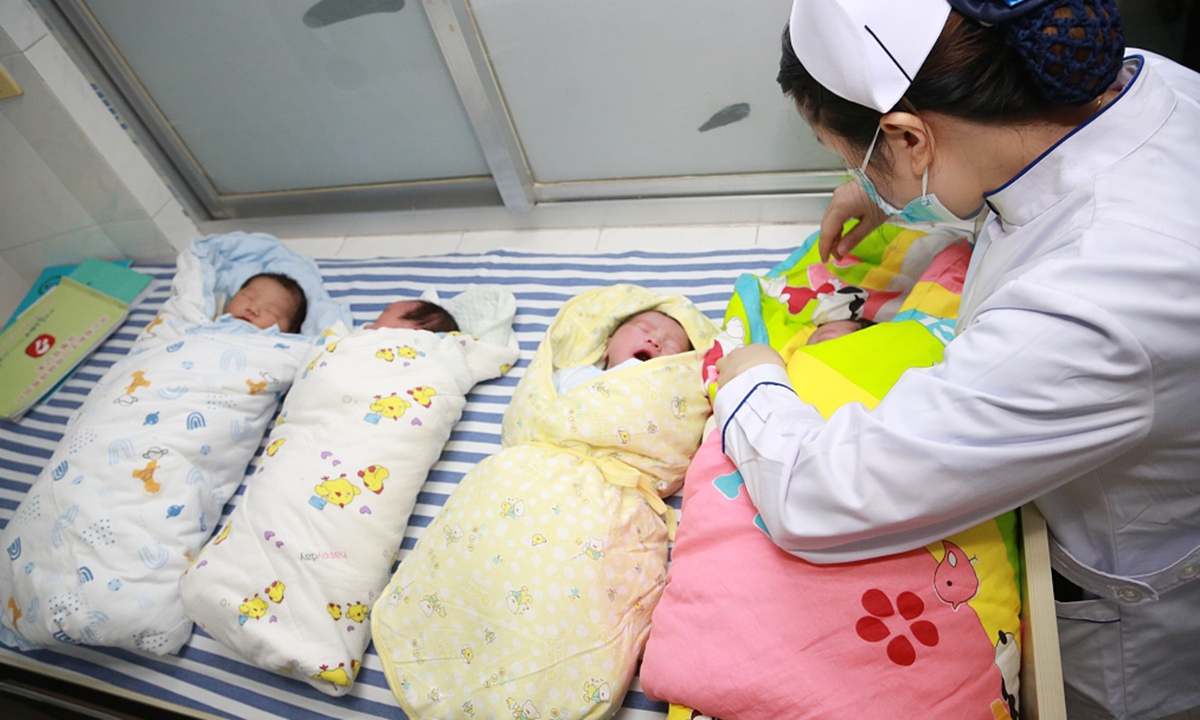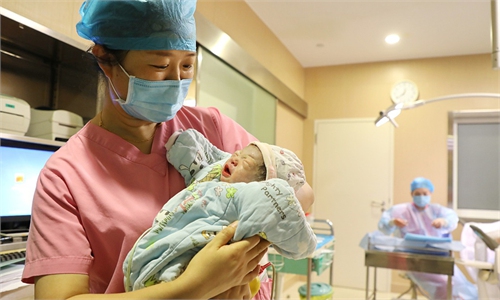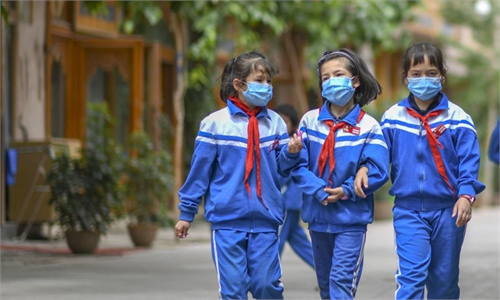3rd-child policy written into Chinese law; expert projects 10% of GDP needed to raise birth rate

Photo:VCG
China on Friday passed a law amendment which allows each couple to have three children and stipulates supportive policies for childbearing, with observers believing it indicates China has officially moved from restricting births to encouraging births, paving the way for not only the third-child policy's full implementation across the country, but also potentially encouraging even more births.
It took less than three months for the policy to be made into law after it was first announced on May 31 at a meeting of the Political Bureau of the Communist Party of China (CPC) Central Committee, revealing the urgency and gravity of China's population development beset by falling fertility rates, a shrinking workforce and increasing aging population, Chinese observers said.
The comprehensive supportive measures for the shift of the population policy - which were not highlighted in the last revision - show China's strong determination in actively tackling its population challenges and building a fertility-friendly society, and more detailed measures are expected to be introduced soon, they said.
The amendment to the Population and Family Planning Law was passed at a session of the National People's Congress Standing Committee on Friday.
The amendment says one couple can have three children, and it cancels relevant restrictive measures, including social maintenance fees and fines on couples who violate the law to have more children than permitted.
Twenty-one provisions were amended, deleted or added to the law, and the amendment took effect immediately after its announcement on Friday, the Xinhua News Agency reported.
The law also introduces supportive measures for the policy shift, including the exploration of parental leave and the establishment of more nursery facilities in residential communities, public areas and workplaces.
The amendment added that the country promotes an appropriate level of fertility, optimized population structure and long-term balanced population development.
China will adopt supportive measures in finance, tax, insurance, education, housing and employment sectors to reduce the burden of childbearing, parenting and education, according to the amendment.
Couples whose only child is accidentally injured, disabled or died shall receive a subsidy, and an all-round mechanism involving healthcare and spiritual comfort shall be strengthened, the amendment added.
Yu Xuejun, deputy head of the National Health Commission, said that the amendment focuses on promoting a long-term balanced development of the country's population, highlighting the implementation of the third-child policy, the abolition of social maintenance fees and other restrictive measures, as well as the implementation of positive supportive measures.
The Population and Family Planning Law was enacted in 2002 and revised in 2015, when China's second-child policy was fully implemented.

File photo:Xinhua
He Yafu, an independent demographer, told the Global Times on Friday that legalizing the policy provides the basis for China's local governments to revise their family planning regulations and speed up the implementation of the policy nationwide.
It also serves as a legal basis for local governments to abolish some local restrictive rules, such as administrative punishment for civil servants that give birth to more children than permitted, He said.
Lu Jiehua, a professor of sociology at Peking University, told the Global Times on Friday that China was forced to speed up the legalization of the policy and supportive measures due to the grim situation surrounding extremely low birth rates - lower than most demographers' expectations.
China recorded 12 million births in 2020, marking a drop for the fourth consecutive year, and the country's total fertility rate of women of childbearing age was only 1.3, lower than the international standard for a "highly sensitive warning line" of 1.5, according to the results of the seventh national population census released by the National Bureau of Statistics in May.
Some Chinese demographers warned that the number of newborns is likely to drop to below 10 million in a few years, and if no forceful intervention policy was introduced, China's fertility rate may become the lowest in the world.
Legalizing the third-child policy indicates that China has officially altered its decades-long family planning policy from one that restricts births to one that encourages them, which is part of its efforts to build a fertility-friendly society, observers said.
The policy may not immediately reverse the declining birth rate and aging population, but it would slow the decline with comprehensive supporting measures, He said.
The next step, observers said, will involve removing the cap on the number of children a couple can have to encourage more births as China's population begins to shrink as early as 2022.

Parents and their children take part in a parent-child activity in Chengdu, capital of southwest China's Sichuan Province, July 2, 2017.File photo:Xinhua
Detailed supportive measures expected
Although the detailed supportive measures are yet to be released, Liang Jianzhang, an economics professor at Peking University, told the Global Times that China needs to spend 2 percent of its GDP to improve its fertility rate to the level of Japan or 10 percent to raise the fertility rate to the replacement level of 2.1.
Much of China's annual savings and investment is spent on building roads, railways, factories and so on, but in the future, the needs of these areas will become saturated, and we could use this money to help more families reduce the childbearing burden, He said.
In fact, some Chinese cities have started to offer cash to families that have two or more children. Panzhihua in Southwest China's Sichuan Province recently announced cash handouts of 500 yuan ($76.87) per baby every month for local families that have a second or third child, until the babies turn 3 years old.
The detailed supportive measures may vary in different cities due to the local economy and people's willingness to give birth, observers said.
Several Chinese cities including Ji'nan in East China's Shandong Province and Xi'an in Northwest China's Shaanxi Province have carried out comprehensive investigations regarding the fertility wishes of women at childbearing age since early June.
The investigation in Ji'nan showed that about 11.2 percent of surveyed rural families said they would love to have a third child, but only 4.3 percent of urban families have the same intentions.
Chinese economist Ren Zeping, also dean of Evergrande Research Institute, said in an article published on his public WeChat account on Monday that in the future, with the accelerated arrival of an aging society, first-tier cities will need to offer 3,000-5,000 yuan in monthly handouts for families that have a third child. "In my opinion, China is already five years too late with such a plan. It shouldn't wait any longer to encourage childbirth," Ren said.
Should births cap be removed?
Some demographers like He hailed the law partially because it removed the social maintenance fee, indicating that couples who have more than three babies will not be punished or fined, and it actually loosens all restrictions on how many children a couple can have.
Some netizens have also commented that China is actually encouraging couples to have four or more children by removing the fines.
However, Lu said that this is not a full lifting of the family planning policy, as the amendment did not mention the complete removal of the policy.
But if the supportive measures of the third-child policy fail to achieve the desired effect to boost birth rates, China may come up with stronger incentive measures and even remove the cap on children, Lu said.
Yang Wenzhuang, an official of the National Health Commission, said in July that the country does not have any restrictions or punishments for couples that have four or more children, but according to population monitoring and research, very few Chinese couples have four or more children.




